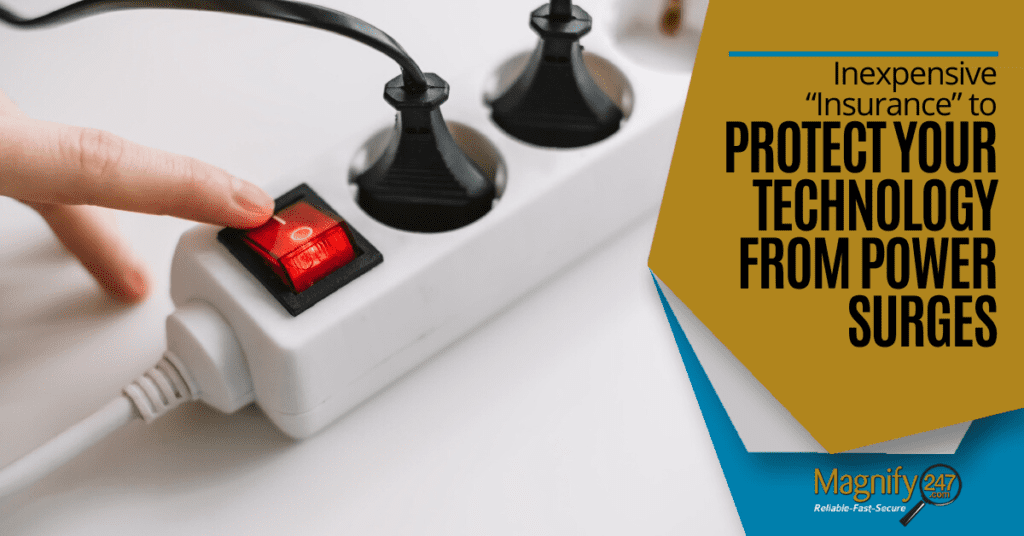
When you think about events that can damage your computer and other technology, what first springs to mind are typically things like liquid spills, a hard drive crash, or being dropped.
watch a short video > https://youtu.be/cVMt95nWf_s
But another dangerous event that can hurt your devices can be a power surge during a storm or a sudden drop in current.
Most technology relies on a continuous stream of power, and many devices are kept plugged in nearly 24/7. A sudden loss of electricity or a power surge can both harm your computer and technology services.
Sudden Loss of Power
Sudden loss of electricity bypasses a computer’s normal shutdown sequence that happens when powering off. This can cause problems with software and potentially corrupt files.
One of the biggest issues that can happen from a sudden power loss is if problems occur with the operating system. For example, if it was in the middle of updating important files, having that task interrupted can cause boot issues. This is why some Windows updates will warn you not to shut off or disconnect your computer from power during the update process.
Power Surges
A power surge can be much more damaging to a laptop or tower, specifically to the power supply unit (PSU). Surges tend to hit right before a power outage and can be caused by lightning strikes or several other events.
While lightning is the most recognizable cause of a power surge, it’s not the most common. Several common causes of a power surge are:
- Operation of high-power electrical devices (air conditioners, elevators, etc.)
- Faulty wiring
- Issues with power company equipment
- Downed power lines
During a power surge, the electrical charge is boosted, sending more electrical current to a device than it can handle. This often results in the system being critically damaged.
If the surge is smaller, then the damage may only happen to the power supply unit. But if it’s a larger surge of electricity, it can move through the PSU to the other computer components (motherboard, processor, graphics card) and basically “fry” them
What to Look for in a Good Surge Protector
One of the best ways to keep your computer protected from potential power surges is to purchase a surge protector. This inexpensive “insurance” can pay off in a big way by protecting your computer in the case of a surge of electrical current. Using a surge protector is one of the best practices for setting up a new computer.
Here are some tips on choosing a reliable surge protector to keep your computer protected.
Make Sure It’s Not Just a Power Strip
Power strips and surge protectors can look identical. Both will have a row of outlets that allow you to expand the capacity of a wall outlet. But power strips don’t protect against electrical surges.
Make sure that you find a strip of outlets that specially states it is a surge protector.
The More Joules the Better
When shopping for surge protectors, you’ll find a measurement listed called joules. This is the amount of electrical charge that a surge protector can handle, either all at once or in smaller increments.
The number of joules of protection you get will vary widely. And sometimes the price difference will be very slight between a small and large number of joules. For example, we looked up two models on Amazon, one was $11.97 (1440 joules) and one was $16.99 (4500 joules), the one that was about $5.00 more offered 3,100 more joules of protection.
So, you want to be sure to check that factor. The higher the joules, the more protection the surge protector offers.
Check for the Warranty
You will find a warranty on some surge protectors, so that’s another consideration when shopping for one. Look for warranties that protect your connected equipment up to a certain dollar amount if damaged by a surge while plugged into the protector.
Get One That Gives You Outlet Space
Some surge protectors have just two prongs that extend from a large box of outlets. This is designed to sit flat against the wall, but if you want to plug anything into a second outlet on that wall plug, it will be pretty much impossible.
You may want to get a strip design with one extended plug instead that will still allow a second outlet on the wall to be used.
Protect Against Sudden Power Outages Too
You can also protect against sudden loss of power by getting a combination battery backup with surge protection. The battery backup can hold a small amount of charge and keep electronics from suddenly being turned off in the event of a full power outage or just a short loss of electricity for a second or two.
These cost more but offer both types of protection and can generally give you anywhere between 15-30 minutes (depending upon model) of additional power for a device.
Keep Your Computer Running Smoothly with Help from Magnify247.com
Whether you’ve had a power surge issue or just want to speed up a slow computer. We can help with fast and expert computer repairs.






